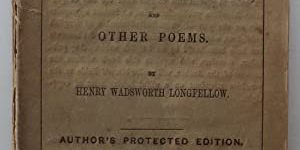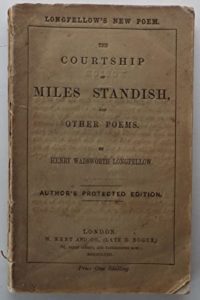 On March 1, 1858, The Courtship of Miles Standish was published from the hand of the American “poet of Hearth and Home,” Henry Wadsworth Longfellow. The distinctives of good literature (called classics) include inspiring a love for God, His Word, as well as the home and family. We can be thankful that in America we have had many such classics that have given us a love of the above as well as a love for the civil liberty that is the result of the religious liberty of conscience practiced and pioneered throughout our history. A poem such as this invokes questions such as who we are as a people and where our ideals come from. The Courtship of Miles Standish illustrates all of these qualities.
On March 1, 1858, The Courtship of Miles Standish was published from the hand of the American “poet of Hearth and Home,” Henry Wadsworth Longfellow. The distinctives of good literature (called classics) include inspiring a love for God, His Word, as well as the home and family. We can be thankful that in America we have had many such classics that have given us a love of the above as well as a love for the civil liberty that is the result of the religious liberty of conscience practiced and pioneered throughout our history. A poem such as this invokes questions such as who we are as a people and where our ideals come from. The Courtship of Miles Standish illustrates all of these qualities.
After he wrote his 200-page masterpiece Hiawatha, Wadsworth wrote in his diary, “Soft as spring. I begin a new poem, Priscilla, to be a kind of Puritan pastoral; the subject, the courtship of Miles Standish.” The next day he continued, “My poem is in hexameters; an idyll of the Old Colony times, a bunch of Mayflowers from the Plymouth woods. What it will turn out I do not know, but it gives me pleasure to write it, and that I count for something.” Midway through he changed the name. Using the resources Chronicles of the Pilgrim Fathers (by Young) and History of New England (by Charles Elliott) he was able to creatively bring to life three dimensional scenes from our Pilgrim heritage.
Henry Wadsworth Longfellow was born in Maine in 1807 and was raised in a family where the Bible was read and Christianity was practiced. His mother was a descendant of John Alden of the Mayflower. He went to Bowdoin College and then taught at 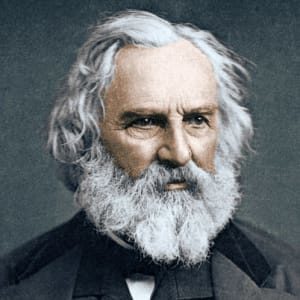 Bowdoin and Harvard. He mastered twelve languages and was a literary translator. His poems and writings are memorable in that they have given Americans and school children a common memory of our heritage and an honor of good character as defined by biblical morals. He married Francis Appleton with whom he had six children. Though experiencing great loss (of his wife and son during the time of the Civil War), he never lost his faith.
Bowdoin and Harvard. He mastered twelve languages and was a literary translator. His poems and writings are memorable in that they have given Americans and school children a common memory of our heritage and an honor of good character as defined by biblical morals. He married Francis Appleton with whom he had six children. Though experiencing great loss (of his wife and son during the time of the Civil War), he never lost his faith.
We are not sure exactly when Miles Standish was born, but he appears to have been bred into wealth. Nathaniel Morton writes in his Memorial that “in his younger time he went over into the Low-Countries, and was a Soldier there, and became acquainted with the Church of Leyden, and came over into New England with such of them as at the first set out for the Planting of their Plantation of New-Plimoth, and bare a deep share of their first difficulties, and was always very faithful to their interest.” It is interesting to note that his first name actually means “soldier.” Though John Smith had offered his services to the Pilgrims in Leyden, they chose Standish instead since he was willing to be a shareholder.
On February 17, 1621, Miles Standish was voted in as captain, and also established their first military orders. Known as Militia Day today (now February 27 due to the change in calendar), it was Standish that was also part of the small delegation making contact with the Wampanoag, culminating in the Peace Treaty. Though never an official member of the Church through confession, he endeared himself to the Pilgrims that first winter in the way he served each of them, risking his own life in the process.
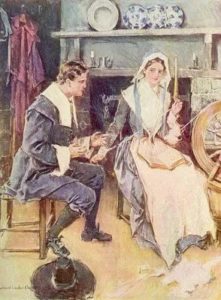 The legendary proposal (based on a family story handed down through the generations to Longfellow) from Miles Standish (whose wife Rose had died during the first winter) to Priscilla Mullins is given below. John Alden, the messenger for Standish, already had feelings for Priscilla. Now, with great respect to Standish, he had to dutifully deliver a proposal for another!
The legendary proposal (based on a family story handed down through the generations to Longfellow) from Miles Standish (whose wife Rose had died during the first winter) to Priscilla Mullins is given below. John Alden, the messenger for Standish, already had feelings for Priscilla. Now, with great respect to Standish, he had to dutifully deliver a proposal for another!
Any woman in Plymouth, nay, any woman in England,
Might be happy and proud to be called the wife of Miles Standish!
But as he warmed and glowed, in his simple and eloquent language,
Quite forgetful of self, and full of the praise of his rival,
Archly the maiden smiled, and, with eyes overrunning with laughter,
Said, in a tremulous voice, “Why don’t you speak for yourself, John?”
Standish was probably about 36 years old, John 22, and Priscilla 18 in 1621. Priscilla was an orphan whose father, mother, and brother all died the first winter. Like Standish, John was not initially a part of the Pilgrim church, but was hired as a cooper (to make and maintain wooden barrels or casks) and was free to leave with the Mayflower or remain. He remained and married Priscilla sometime before 1623. The alleged thought process of Priscilla regarding Standish’s proposal is given by Longfellow:
Why does he (Standish) not come himself, and take the trouble to woo me?
If I am not worth the wooing, I sure am not worth the winning…
When one is truly in love, one not only says it, but shows it.
Had he but waited awhile, had he only showed that he loved me,
Even this Captain of yours – who knows? – at last might have won me,
Old and rough as he is; but now it never can happen.
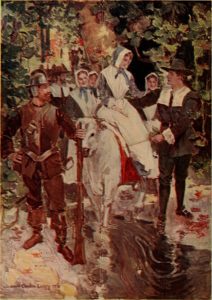 The entire poem is set in the context of biblical ideas. There are numerous Scriptural references and biblical imagery in the poem. The concept of courtship itself is uniquely drawn from biblical precepts. The best translation of 1st Thessalonians 4:4 (RSV) is “that each of you know how to take a wife for himself in holiness and honor.” The process of finding a wife can be honorable and set godly habits throughout a marriage. Courtship is a process where parents (and others) give relational accountability.
The entire poem is set in the context of biblical ideas. There are numerous Scriptural references and biblical imagery in the poem. The concept of courtship itself is uniquely drawn from biblical precepts. The best translation of 1st Thessalonians 4:4 (RSV) is “that each of you know how to take a wife for himself in holiness and honor.” The process of finding a wife can be honorable and set godly habits throughout a marriage. Courtship is a process where parents (and others) give relational accountability.
From the time of the Pilgrims, courtship was an accepted practice. In analyzing the practices of the Pilgrims with respect to courtship, John Demos writes that it would have taken place “under the watchful eye of parents and siblings, or indeed of a whole neighborhood.” In her article entitled “Front Porch to Back Seat,” Beth Bailey describes the dramatic change “dating” made in America: “Dating moved courtship into the public world, relocating it from family parlors and community events… from the implied supervision of the private sphere…to the anonymity of the public sphere.”
Restoring poems like Longfellow’s in our children’s education is critical to preserve our heritage and give the next generation a vision for the future. Let us preserve the future of our nation by teaching the best of our past! We urge each of you to influence your children, grandchildren, and others to do so! Our nation’s future is in the hands of the new generation of youth arising with quality education! Though a small remnant right now, let us pray that we will see a revival of quality teaching and learning.

